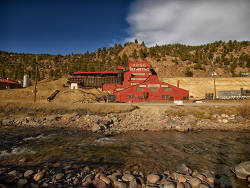Argo Gold Mill and Museum
Useful Information
| Location: |
Idaho Springs.
I-70, 26 km west of Denver. |
| Open: |
Mid-APR to mid-OCT daily 9-18. Mid-OCT to mid-APR by appointment. [2007] |
| Fee: |
Adults USD 15, Children (7-12) USD 7.50, Children (0-6) free. Groups (25+): Adults USD 11.50, Children (7-12) USD 7. Groups (50+): Adults USD 10.50, Children (7-12) USD 6. [2007] |
| Classification: |
 Gold Mine Gold Mine
|
| Light: |
 Electric Light Electric Light
|
| Dimension: | |
| Guided tours: | |
| Photography: | |
| Accessibility: | |
| Bibliography: | |
| Address: |
Argo Gold Mill and Museum, P.O. Box 1990, Idaho Springs, Colorado 80452, Tel: +1-303-567-2421. off season: Tel: +1-303-567-2354.
E-mail: |
| As far as we know this information was accurate when it was published (see years in brackets), but may have changed since then. Please check rates and details directly with the companies in question if you need more recent info. |
|
History
| 1859 | George A. Jackson makes the first major discovery of gold in Colorado at Idaho Springs. |
| 1893 | beginning of construction of the Argo Tunnel. |
| 1910 | Argo Tunnel reaches Central City. |
| 1943 | tunnel and mill closed, after the tunnel was filled by a flood. |
| FEB-1976 | purchased by James N. Maxwell to preserve it. |
| 1977 | placed on the National Historic Register by the Department of the Interior. |
Geology
A typical gold deposit, with placer gold in the valley floor, which was mined first. Later the miners followed the trail of gold to its source in the mountain. The gold bearing quartz vein was mined, which was called hard rock lode mining.
Description

The Argo Gold Mill is pretty prominent with its huge red buildings. They were built before 1900 to process the gold bearing ore from various mines of the area. Most of those mines were connected with the mill through the Argo Tunnel, which was completed in 1900 after 17 years of work. The 7.5 km long adit was built for water drainage, ventilation, and economical transportation of the gold bearing ore. The tour includes a visit to the adit, the Double Eagle gold mine and the mill. There is a live demonstration of the crushing, milling and rock drilling.
Idaho Springs is the location of the great Rocky Mountain goldrush. It was started when George A. Jackson made the first discovery of gold in January 1859. Almost overnight 50,000 men poured into Clear Creek Canyon. Between 1859 and 1861, more than 13,000 mining claims were recorded. After the placer gold was worked out, the miners searched for the gold bearing vein and started the so caled hard rock lode mining. In 1902, more than 300 mines were operated in the Idaho Spring area. Many successful mines were on Seaton Mountain between Idaho Springs and Central City. Quartz Hill was home of the Glory Hole, called the richest square mile on earth.
But the miners had the same problems as always: increasing depth and increasing problems with water in the mines. The solution was the same as hundreds of years before: an adit. Adits are tunnels which are built from the mine to a deep valley nearby. It the valley is deeper than the mine, the water may just flow out without the need to pump it to the surface. Also the ore may be carried out this way, as an ore railway would also go downhill, without the need to lift the ore to the surface. Such an adit was the Argo Tunnel, 3.60 m wide with two railway tracks and a drainage ditch in the center. The second half was only half the diameter, as the need was less towards the end. The tunnel has a .3 downhill grade, which was enough for the water to drain the water. It ran across Virginia Canyon, Gilpin Gulch, Russel Gulch, Quartz Hill, Nevadaville, and Central City.
Samuel Newhouse, Thomas Weir and John Montgomery formed a partnership in Leadville. They formed a corporation to sell stock and raise the money needed for the adit, which was the largest mining project in the world and when it was completed the longest tunnel in the world. The tunnel was dug using hand drill and hammer for the holes and black powder. But at this time pneumatic drills were developed and soon used at the tunnel. The first drills were pretty dangerous, so they were called Widow Makers. Soon they were modified and became safer. Dynamite became available and electricity introduced at Idaho Springs, the mules which pulle dthe carts were repaced by electric locomotives. The construction speed of the tunnel increased continually, and the miners were setting new records for the amount of blasted rock. The adit was finally completed in 1910.
The Argo Mill at the tunnel entrance was built by R.E. Shimer who had bought the Argo Reduction and Ore Purchasing Company before. He created one of the largest and most modern three-hundred ton mills in the United States. The ore was delivered by the miner cars to 50 ton storage bins, from where an electric belt conveyor transported the ore to the chain bucket elevator. It raised the to the top of the mill where a big stamp mill pulverized the ore. The precious metals were extracted by the addition of ammonium salts. Then came amalgamation, flotation, a cyanide process, and gravity systems.
 Search DuckDuckGo for "Argo Gold Mill and Museum"
Search DuckDuckGo for "Argo Gold Mill and Museum" Google Earth Placemark
Google Earth Placemark Historic Argo Gold Mine Mill and Museum Adventure Tours, official website.
Historic Argo Gold Mine Mill and Museum Adventure Tours, official website. Index
Index Topics
Topics Hierarchical
Hierarchical Countries
Countries Maps
Maps